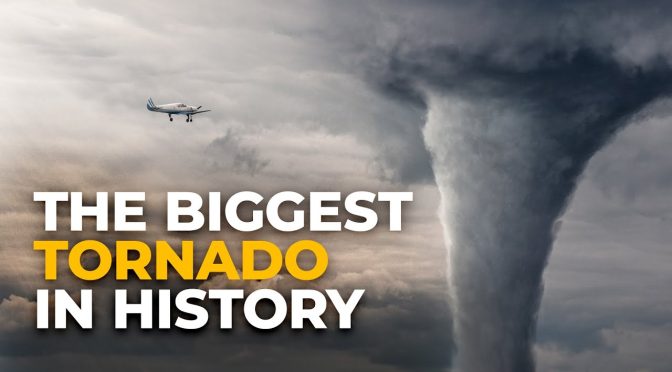Based on the video titled “How Super Tornadoes Are Born” by Real Science, this article delves into the formation, impact, and the science behind tornadoes. Tornadoes, with their immense power and unpredictability, have long been a subject of both fascination and fear. This article aims to shed light on these natural phenomena, their origins, and the efforts being made to predict and understand them.
Contents
- The Terrifying Reality of Tornadoes
- The Science Behind Tornado Formation
- Measuring Tornado Intensity
- The Deadliest Tornadoes
- The Quest for Better Predictions
- Essential Tips for Safety
- The video
- Conclusion
The Terrifying Reality of Tornadoes
Imagine standing by your window, watching dark clouds unleash rain and hail, when suddenly a twisting column descends from the sky. This column, initially suspended, soon makes contact with the ground, turning darker as it picks up debris. Such is the terrifying reality of tornadoes. While they can occur anywhere, the United States witnesses the majority of them, even more than the combined yearly average of all other countries. The U.S. also experiences the most violent tornadoes, which unfortunately result in the highest number of casualties. For instance, the 2011 Super outbreak, spanning from April 25th to 28th, caused approximately $12 billion in damages and took 321 lives.
The Science Behind Tornado Formation
Despite their frequent occurrence, the exact conditions leading to tornado formation remain somewhat elusive. Most tornadoes originate from supercells, storms with a persistent rotating updraft. These supercells arise due to wind shear, where winds at different altitudes blow in varying directions. This creates a horizontal tube of air that, when influenced by rising warm air and falling cool air, becomes vertical, leading to the formation of a mesocyclone. This mesocyclone can then give birth to a tornado. However, the exact conditions for tornado formation are still under investigation. Projects like the Verification of the Origins of Rotation in Tornadoes Experiment (VORTEX) have been launched to gain deeper insights.
Measuring Tornado Intensity
After a tornado’s passage, experts assess the damage to determine its intensity. Using the Enhanced Fujita Scale, they assign a rating from zero to five, which also helps estimate wind speeds. For instance, the Bridge Creek Moore tornado of 1999, with wind speeds of 512 kilometers per hour, was classified as EF5. However, the scale’s limitations mean that even more powerful tornadoes might not receive a higher rating.
The Deadliest Tornadoes
While the Bridge Creek Moore tornado was devastating, it wasn’t the deadliest. In 1989, a tornado in Bangladesh claimed over 1,300 lives. In the U.S., the Tri-State Tornado of 1925 holds the grim record, causing 695 deaths. This tornado traveled 350 kilometers across three states, making it the longest-path tornado in history. Another notable tornado was the El Reno tornado of 2013, which, with a width of 4.2 kilometers, is the widest ever recorded.
The Quest for Better Predictions
Predicting tornadoes remains a challenge. While meteorologists can identify potential storm conditions days in advance, pinpointing the exact location and time of a tornado’s formation is more complex. Current warning systems, relying on Doppler radar, often result in false alarms. However, storm chasers, like the late Tim Samaras, have been instrumental in collecting valuable data to enhance our understanding and prediction capabilities. With advancements in radar technology and computational modeling, the hope is to provide more accurate and timely warnings in the future.
Essential Tips for Safety
Tornadoes are powerful and unpredictable natural phenomena. When they strike, preparedness can make the difference between life and death. Here are some essential protection tips everyone should know:
- Stay Informed: Always have a reliable source of weather updates. This could be a weather app, a battery-powered weather radio, or local news channels.
- Plan Ahead: Designate a safe place in your home, preferably a basement or an interior room on the lowest floor, away from windows and corners. Ensure every family member knows its location.
- Prepare an Emergency Kit: This should include water, non-perishable food, a flashlight, batteries, a first-aid kit, necessary medications, and important documents.
- Avoid Windows: Tornadoes can hurl debris at high speeds. Stay away from windows to avoid flying glass and other debris.
- Cover Up: Use mattresses, heavy blankets, or even helmets to protect against falling debris.
- Mobile Homes Are Not Safe: If you live in a mobile home, find a sturdy building or storm shelter nearby where you can seek refuge during a tornado.
- If Outside, Find a Ditch: Lie down in it and cover your head. Avoid seeking shelter under bridges or overpasses.
- Stay Informed Post-Tornado: After the tornado has passed, continue to listen to local news or a NOAA Weather Radio for updated information and instructions.
- Avoid Downed Power Lines: They can cause electric shocks. Report them to the local utility company immediately.
- Stay Calm and Alert: After a tornado, there may be additional hazards. Stay vigilant and be cautious when moving around.
The video
Conclusion
Tornadoes, with their immense power and unpredictability, have long been a subject of both fascination and fear. While understanding their formation and impact is crucial, it’s equally vital to be prepared and know how to protect oneself. With the right knowledge, from the science behind tornadoes to essential safety tips, individuals can better navigate these natural phenomena and ensure their safety.

